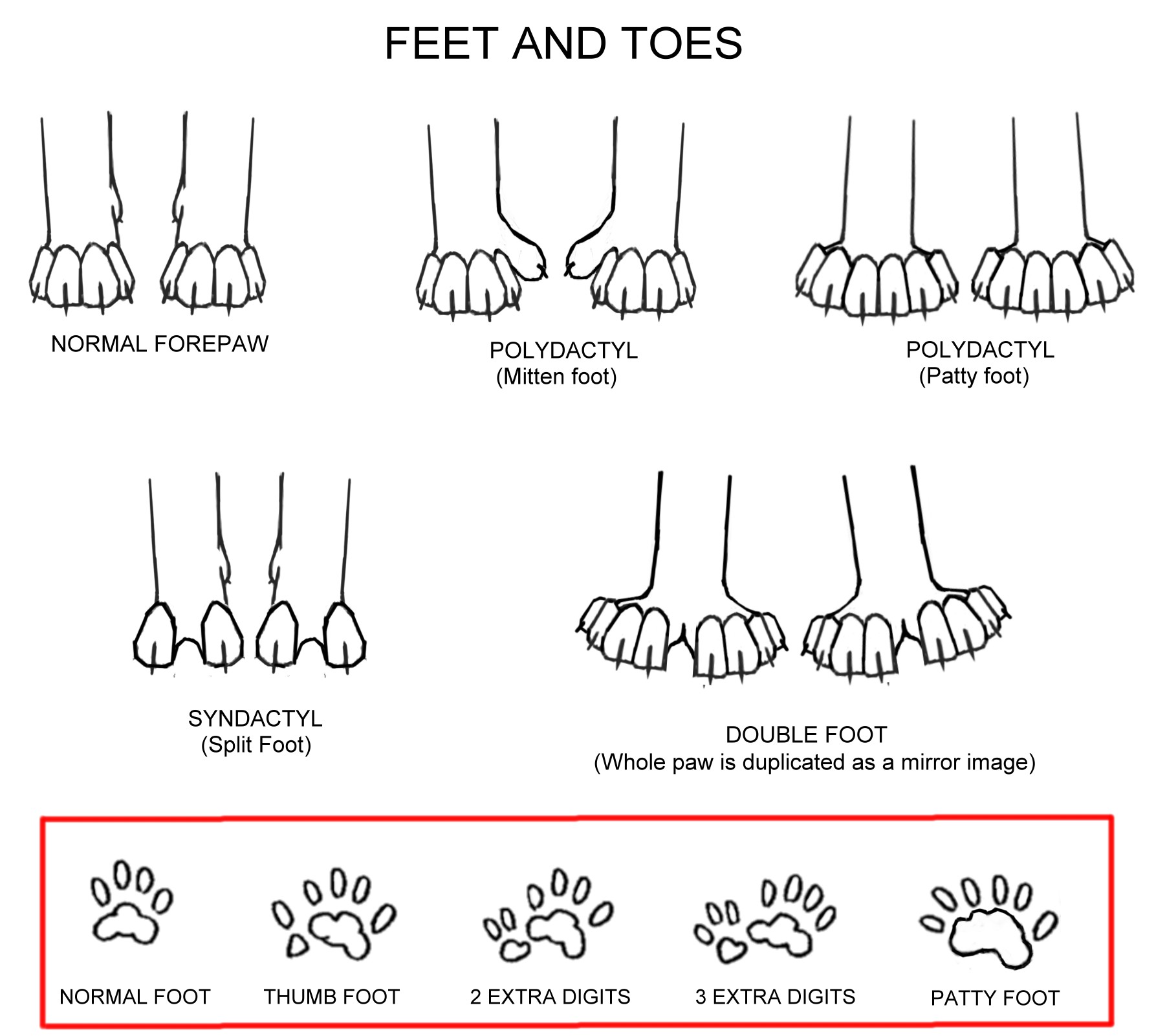|
|
|
|
|
Between one and three extra toes on the front feet |
||
POLYDACTYL CATS (PART 1)
In the New Scientist of 12 May, 2001, it was asserted by Chris Hayes that "five is the magic number" of digits. This was based on the assumption that the genetic mutation that produces the extra toes is also responsible for deformities and that possession of more than five digits is a "counter-survival trait". His assertion was based on observation of mice with deformities caused by genetic mutations. What is true for mice is not necessarily true for other animals and there are many healthy cats with six or more digits. Fossil evidence shows that early amphibians also had 7 or 8 toes.
Polydactyly, or extra digits, is a common trait among cats, particularly it seems, among Celtic cats and cats on part of America's Eastern coast and South West Britain. This distribution may well be linked. Except for Twisty Cats, polydactyly is not a product of bad breeding. It is simply a naturally occurring genetic variation and, as noted later on, polydactyly is found in fossil reptiles - meaning that five digits might be the abnormal form! Only one form of polydactyly is known to be harmful.
In a 1967 issue of Britain's "The Cat" magazine, Mary Collier of Axminster, Devon wrote Can any readers of THE CAT give me any information about 6-toed cats, sometimes called 'Boxers' or 'Boxing Cats'? I have recently acquired a very fine kitten of this type [...] What I particularly want to know is their district or origin, or country if outside the British Isles and the date they may first have been recognised." In February 1978, the Daily Mirror carried a series of letters on polydactyl cats. Jennifer Wellstead, of Penzance, Cornwall, had asked if any other readers had cats with 6 toes on each paw. A "Mrs I" of Kettering, Northants, replied that 6-toed cats were favoured as witches' familiars of witches. Mrs Farley, of Havant, Hampshire, said she had 6 cats, 3 of whom had 6 toes and 2 had 4 toes on each foot in place of the normal 5. She added that a recent litter had produced one kitten with 7 toes, 4 with 6 toes and 2 with the normal number of toes.
Polydactyly (six or seven toes) varies from the classic "mitten cat" through to cats which simply have more toes than normal, but no "thumb". A correspondent to the New Scientist noted that the innermost extra toes on the front paws are often opposable and some cats use them with quite startling proficiency to manipulate small objects with almost human dexterity. Some owners of polydactyl cats joke that their cats are more intelligent because of this and represent the next stage in feline evolution - the ability to open cartons and cans unaided.
|
|
|
|
|
Between one and three extra toes on the front feet |
||
Polydactyl cats are known by various names - "mitten cats", "thumb cats", "six-finger cats", "Cardi cats" and "Hemingway cats". The latter is because of writer Ernest Hemingway who made his home on the small island of Key West, Florida, had a number of polydactyl cats. His colony of cats bred freely with local cats and the ratio of polydactyly to normal-toes was about 50/50. The high rate of polydactyl cats in Boston, USA has also led to the nickname "Boston Thumb Cats". The nickname "double-pawed" cats is a misnomer since there is a specific double paw condition. Polydactyly is also known as hyperdactyly or supernumary digits and occurs in many animals (including humans) as a spontaneous mutation or hereditary trait. The mode of inheritance - dominant or recessive - varies between species.
POLYDACTYLOUS CATS AROUND THE WORLD
In early PixieBob promotional literature "Bigfoot is in the Building!" Brenda Weatherby and Carol Ann Brewer wrote that polydactyly first appeared in Boston in the early 17th century and that polydactyl cats are only found in North America. In actuality, polydactyl cats, being popular ship's cats, may have arrived in Boston from England. Claims that polydactyl cats are not found outside of America are factually incorrect: the trait is found in Britain, some parts of mainland Europe and in Asia. It is common enough in some areas of Britain for it to be almost unremarkable. An article from Cornell University, Cat Watch (1998), cited studies into polydactyl cats from the 1940s through to the 1970s. The study indicated that the trait may have occurred in cats taken to Boston by English Puritans during the 1600s and speculated that the mutation developed in cats already in the Boston area rather than cats in England. The progeny of these cats may have travelled on trading ships from Boston to Yarmouth, Massachusetts and Halifax, Nova Scotia, two areas which also have a high incidence of polydactyly. Charles Darwin wrote of polydactyl cats in his book "The Variation of Animals and Plants Under Domestication" published in the 1850's "I have heard of several families of six-toed cats, in one of which the peculiarity had been transmitted for at least three generations" pre-dating claims elsewhere that the first scientific recording of feline polydactyly was in 1868.
Polydactyl cats are said to be virtually non-existent in Europe, because "unusual looking cats" were destroyed due to witchcraft superstitions, practically eliminating the trait (Kelly, Larson,1993). I do not know whether Britain was included in the generic term "Europe" or whether it meant continental Europe only. In Norway, polydactyl cats are known as "ship's cats" as the extra toes supposedly gave them better balance on ships in stormy weather; they are not uncommon and polydactyl kittens are sought after pets. Polydactyl random-bred cats have been reported in Sweden though other European cat lovers (locations not reported) had apparently never seen a polydactyl. They are common enough in Britain to be considered unremarkable. A polydactyl gene pool has become concentrated in Cardiganshire (Ceredigion), south west Wales; cats with extra toes became common there and known as "Cardi-cats". Six-toed cats are apparently more common in Cardigan (Aberteifi) that elsewhere in Britain; seven-toed cats are also sometimes found in the area. Cardigan/Aberteifi sits on the Teifi estuary above Cardigan Bay and was once one of the busiest shipping ports in Wales which probably explains the high density of polydactyl cats in the area. I regularly saw polydactyl cats at the Chelmsford Cats Protection rescue shelter as well as pwning a polydactyl.
Polydactyl cats were considered "lucky" by sailors. Sailors also believed polydactyl cats to be superior mousers and ratters. Employed as ships' ratters and lucky mascots, they would have reached America with early British settlers hence their greater frequency in Eastern states. A disproportionately high number of "lucky" polydactyl cats, compared to normal-toed cats, would have found their way there. This would lead to a greater proportion of polydactyls than usual for a random-breeding cat population. Back in Britain, with its large cat population of which the polydactyl formed only a small part, the trait remained less common (though there have been localised pockets of higher than average incidence). There is a higher incidence of polydactyly in South-West England, possibly associated with ports from which ships set sail for the New World.
Bjorn B Svingen, owner of a polydactyl cat, provided the following information on polydactyl cats in Norway and their association with ships: "I have heard people say that these genes came to Norway long ago. The story was that the genes were inherited from Spanish or Portuguese ship cats with this 'disorder'. These cats were supposedly common on ships trading on the Norwegian coastline. They have again become popular, at least in our area, and are plentiful in Trondelag in mid Norway." As a result, they are also known there as "Skipskatt" (ship-cat).
In his survey and detailed account of cats in Singapore in 1959, Searle had not noted any polydactyls. The only polydactyls I noted in the Malaysia/Singapore region were the Lake Chini cats. I also found a superb bobtailed polydactyl cat in rural Malaysia (near Kuantan) where "six-finger cats" are considered lucky. Being an unneutered tomcat, the trait would be perpetuated.
|
|
|
|
Two polydactyl kitten from Lake Chini near Kuantan, Malaysia; the father was a bobtailed polydactyl had produced a dynasty of multi-toed kittens on local female cats. |
|
There are two forms of polydactyly described by embryologists. Pre-axial polydactyly refers to extra digits on the inside edge (thumb-side) of the paw. Post-axial polydactyly refers to extra digits on the outer side (little finger side) of the paw and is lesscommon. One of the earliest inheritance studies was by Poulton (probably 1880s/90s) which is mentioned by Thomas Hunt Morgan (Professor of Experimental Zoology, Columbia University) in Experimental Zoology (Publ. Macmillan & Co, London, 1910): Poulton has given some records of polydactyl cats that appear to be exphcable, so far as they go, along Mendelian Hnes. Three young were produced from a polydactyl female by an unknown father. They were all polydactyl. If polydactylism dominates over the normal condition, this result is simple dominance. One of these individuals (F1) produced three litters (by unknown fathers), in which four normal and six abnormal kittens appeared. If the father was normal, five normal and five polydactyl young would be expected. Thus:- (P + N) + (N + N) = (2NP + 2NN) [P being poly foot and N being normal foot]
Sis & Getty (1968) describe polydactyly as an monogenic autosomal dominant trait affecting the pre-axial part of the limb. This is the typical and harmless form of polydactyly though other forms exist. Both Danforth and Chapman & Zeiner proved in their research that normal feline polydactyly is a simple incomplete dominant gene with variable expression. According to geneticist and TICA Genetics Committee Chair Dr Solveig Pflueger "most polydactyl cats... have a form of pre-axial polydactyly with the extra digits(s) on the thumb side of the foot... " The Pd gene causes the entirely harmless form of polydactyl. The main studies on feline polydactyly are Danforth's studies Heredity of Polydactylism (1947) and Morphology of the Feet in Polydactyl Cats (1947) plus Chapman & Zeiner's study The Anatomy of Polydactylism in cats with Observations on Genetic Control (1961). The Danforth and Chapman & Zeiner studies observed examples of both mitten-foot and patty-foot polydactyly in their studies (some refer to the patty foot as "snowshoes" but I avoid that term as there is a cat breed called the Snowshoe). Danforth, and Chapman & Zeiner, stated that polydactyly was never observed in the hind feet except when it was also present in the front feet. A hind-foot polydactyl must have extra digits on the front feet, though sometimes these are not readily discernible and can only be found by x-ray.
The gene(s) for polydactyly specifically affects the tissue formed at the very end of the limb (apical cap) of a developing embryo. This is the area where the toes will form. Danforth studied the way normal pre-axial polydactyly developed in embryos based on data from 150 cats. He discerned evidence of polydactyly in the 20th day of gestation in the form of excess development on the edges of the limb buds that would form the forelimbs. If the apical cap is larger than normal, extra toes will develop from it. It is worth noting that physical damage to the apical cap might also trigger the development of extra toes. Branching of the apical cap will lead to complete double paws or, if it branches early enough, to doubled limbs.
The first major study into classical polydactyly (thumb cats) was conducted in 1947. For his study "Heredity of polydactly in the cat" (Journal of Heredity 38, 107, 1947) Danforth studied two female polydactyl cats that he housed at his laboratory. The cats came from locations 85 km from each other in California, but the possibility of them being related could not be ruled out. He mated these females with different males and recorded the dates of mating and the physical traits of the kittens. He collated additional information from friends with polydactyl cats. He noted that the effects of polydactyly could always be seen on the front paws and sometimes also on the hind paws. On the front paws, the first digit was at least enlarged in one front paw and might be doubled or tripled. If the hind paws were also affected, there was at least a rudimentary dew-claw and sometimes additional claws. Where there was a doubled first digit, it was sometimes incompletely formed with the additional digit between the first digit and the other claws. The position of the first digit was also changed a little from normal to resemble a thumb. The four images show different footprints: a normal-footed front paw and 3 expressions of polydactyly:

Danforth mated all possible combinations of his cats: Poly x Poly, Poly x Non-Poly, Non-Poly x Non-Poly. This confirmed that polydactyly was a dominant gene, because in every mating where at least one parent was polydactyly there were polydactyl offspring. In matings between two normal-footed cats there were never any polydactyl offspring. In 3 matings, all offspring were polydactyl and therefore one or both parents were probably homozygous for polydactyly.
In guinea pigs, one form of polydactyly is lethal when homozygous. Danforth's studies indicated that this was not the case in cats. In a mating Pp x Pp (heterozygous parents) on average 25 % of the young will be homozygous for polydactyly, 50 % heterozygous for polydactyly and 25 % normal-footed. If the gene was lethal, the 25% of homozygous offspring would die before birth and the litters therefore would be smaller than expected. Danforth found the average litters to be almost the same size (4.12 with offspring homozygous for polydactyly compared to 4.35 for litters where no offspring could be homozygous). This also affected the ratio of polydactyl and normal-footed offspring in a litter. If the gene was lethal when homozygous, there would be (on average) 2 poly kittens for every normal-footed kitten. Danforth's cats produced a ratio of 77 poly kittens to 22 normal-footed kittens.
|
Offspring polydactyl |
Offspring normal |
|
|||
Probable Mating |
Observed |
Expected |
Observed |
Expected |
Total |
PP x Pp |
8 |
8 |
0 |
0 |
8 |
PP x pp |
11 |
11 |
0 |
0 |
11 |
Pp x Pp |
69 |
68.25 |
22 |
22.75 |
91 |
Pp x pp |
33 |
31.5 |
30 |
31.5 |
63 |
pp x pp |
0 |
0 |
61 |
61 |
61 |
From these studies, Danforth concluded that polydactyly (at least the form that he studied) was a variably expressed dominant gene: "these data lend no support to the assumption that polydactyly in the cat is lethal when homozygous" nor was it associated with the cat's gender "The trait is not related to sex, and no evidence is found that its gene is lethal" He found no evidence of split foot or radial hypoplasia (a.k.a. radial hemimelia) in his studies though his second study into feline polydactyly ("Morphology of the Feet in Polydactyl Cats", 1947) found that cats with 6 metatarsals (toes) tended to have fusion at the ulna which caused varying degrees of rotation of the joint of the radius.
| Useful Formula For Describing Polydactyl Front Paws | |
| Normal front foot | 4 |
| Foot with extra toes that do not form a thumb (patty foot) | 5; 6 (etc) |
| Mitten foot with thumb (single digit) | 4+1 |
| Mitten foot with 2 or more extra toes | 4+2; 4+3 etc |
| Mitten foot where extra claws are tucked between the
normal foot and "thumb": (the numbers in brackets mean extra claws that aren't on a fully developed toe) |
4+(1)+1; 4+(2)+1; 4+(1)+2 (etc) |
In 1955, Albert C Jude, author of "Cat Genetics" documented two forms of polydactyly. He wrote that polydactylism (extra digits), and oligodactylism (reduction of toe number) were sometimes reported by the fancy, but were the exception (not selected for) rather than the rule within cat breeding. This meant little data was available on feline polydactyly to permit proper scientific study. He noted that polydactyly involving only the preaxial side of the limb had been documented in cats by Danforth in 1947 and was dominant over the normal form. Most cases of polydactylism in cats observed by Jude had affected the front feet only. In his 1955 book Jude also described a form of polydactyly which he called "posterior reduplication": Another interesting deformity - only very occasionally seen in cats, but more frequently seen in some other animals - is known as "posterior reduplication." The condition was found in a stock of mice by Danforth in 1923, and a described by him in 1930. The information came from Mrs. A. Winsor of Hull, a well-known English Abyssinian breeder: "Before the war, I had two little black she-cats. One came into season, and a strange gray tom came to investigate. His feet were really amazing. His front legs were very thick and stout, big feet, with normal number of toes. On the inner side of each foot was another smaller foot. A sort of stalk grew from the ankle, as if the ankle bone had been split, and this ended in a complete foot which rested on the ground alongside the normal foot, and turned slightly inward, When sitting he had to advance one leg, as he could not possibly put all his four feet side by side, and when walking he sort of lifted one foot over the other. He mated my queen who was calling at the time and there were two black kittens whom we put to sleep, and two gray-striped, both females. One had just thumbs; the other had seven toes - four ordinary, and three extra where the thumb would be. There was no stalk, but these three toes had a separate pad; they were about the same length as the others, and her feet spread out like paws. She also had a sort of 'thumb' half-way up each hind foot, with a claw on the end. The other gray-striped female - the one that had just thumbs - we kept for eight years and then she died. I managed to get a granddaughter who is now seven years old. She has had countless kittens, and about half of every lifter have the 'Family Feet.' "
According to the late Roy Robinson in his book "Genetics for Cat Breeders", there is considerable variation in the number of extra toes and in how well-formed they are. The trait ranges from an enlargement of the inside digit into a "thumb" to the formation of three apparently well formed extra toes (i.e. 7 toes on the affected foot). A cat may even have different numbers of toes on each of its front feet.
The hind feet are rarely affected and are only ever affected if the front feet are also affected. I have received a report of a Maine Coon with hind foot polydactyly and apparently normal fore paws; it seems likely that it was genetically polydactyl for all four paws, but that the extra toes had not been visibly expressed in the fore paws for some reason. I also received the following report about a random-bred hind-foot polydactyl with normal front paws.
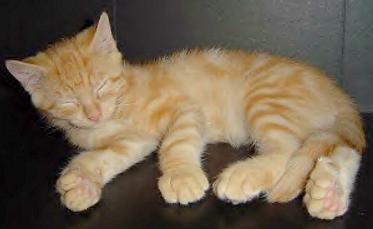 Rufus (Photo Karen Kohl) |
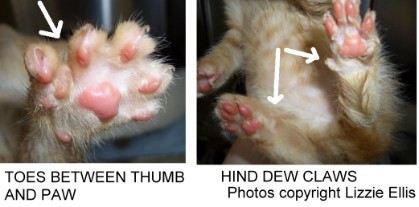 |
Karen Kohl's orange tabby kitten (Rufus, pictured) has no thumbs on his front paws and apparently normal front dew claws ("a short splinter of a nail on the inside of his left front paw"), but has 6 toes on each of his hind paws. The inside toes of each hind paw are thumb-like and have both a toe pad and an extra palm pad. One of them is retractile like his other toes and one isn't. Rufus was born in Boston in June, 2003. He and two normal-toed brothers were rescued feral kittens and probably inbred. Rufus was the only healthy one of the three. They were taken to a local cat shelter which had seen one or two cats with more toes on the back paws than on the front so Rufus isn't the only one and this form of polydactyly me be present in the local feral population. One explanation is that the polydactyly of the front paw has been suppressed by other genes. An alternative is that Rufus and other cats in that area have a mutation which affects only the hind paws - a form of polydactyly previously only seen leopards. Boston has a high incidence of polydactyly; either due to mutations occurring there or due to "lucky" polydactylous ships' cats being taken there with early settlers.
The normal cat's front paw has 4 toes and one dewclaw (rudimentary toe or thumb which does not touch the ground) while the back paw has 4 toes. A polydactyl will usually have one or two extra toes on each foot. Most polydactyl cats have a form of pre-axial (i.e. situated in front of the axis of a limb) polydactyly with the extra toes appearing on the thumb side of the foot. The gene for Polydactyly can give rise to either extra toes or extra dewclaws. Each extra toe has its own terminal pad (fingertip) and normally an additional palmar pad and additional plantar pad. When extra toes occur on the hind paws, these are not generally dewclaw. Some owners report their cats have five toes on the hind paws, however by definition a dewclaw does not touch the ground. Possession of a hind dewclaw or extra digit is considered a throwback in cats, but is relatively common in dogs (a photo is shown below for comparison).
|
Single or double dewclaws occur on the back feet of some dogs (double dewclaw shown here). By definition, dewclaws do not touch the ground. |
The back paws are only affected if the front paws are also affected. Unlike the front paws, there are not usually distinct "thumbs". |
Zelda Anabelle (see note below). |
In August 2002, Dominic emailed about the appearance of "thumbs" on the back feet of a polydactyl cat. Both of his polydactyl kittens appeared to have rear thumbs with claws (which were not fully retractile, probably due to the kittens' young age). The photo above is one of Zelda Annabelle's hind feet. On closer examination, the extra hind toe is not really a thumb. To be a thumb it needs to have not only a terminal pad (the "fingertip") but also a palm pad (like the palm of a person's hand or the ball of a person's thumb). A feline "thumb" sticks out at a different angle to the other toes, like the thumb of a mitten. It can be wiggled independently of the rest of the foot. Zelda Annabelle's additional hind toes are typical of polydactyl back feet - they do not have the palm-pads and they follow the curve of the foot. Because the hind paws are constructed differently to the fore paws, there are rarely true "thumbs" on the back feet (only one or two reported cases of opposable hind thumbs, but no photographic evidence). Robert O'Rourke's "Paulie" (Paulie-dactyl!) also has extra palm pads on the back feet.
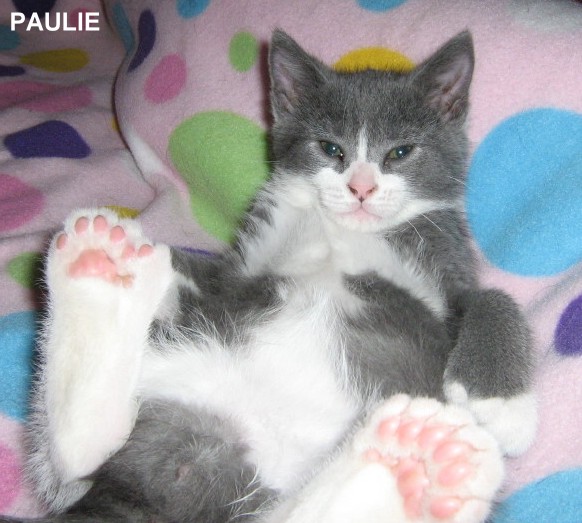
In reviewing the various reports of polydactyly, Robinson noted that many indicate a dominant gene, but that not all cases need be due to the same mutant gene. It is possible for the exact same gene to have arisen by mutation in different localities at different times which could account for the similar heredity. Some gene loci (areas of chromosome) are more prone to mutation than are others. However, Robinson cautioned his reader that other cases of polydactyly might prove to be inherited differently.
During the 1990s, other researchers reported forms of polydactyly which they believed to be recessive. One researcher into feline curiosities suggested two different dominant forms and one recessive form all of which had subtly different effects on the structure of the paw. This was based on the sudden appearance of polydactyl cats in a population of normal-toed cats. This could only have occurred through a gene mutation or through recessive genes. Apparently the evidence among a number of random-breeding cats suggested a recessive gene for polydactyly.
Dan Williams contacted me in July 2006 about a localised population of cats with about 5-10% polydactyls in Syracuse, Central New York. The "7-toed cats" that are consistent in conformation: 4 regular toes, with an extra toe just outside the innermost digit, but the foot sits flat, including the innermost digit. The 7th toe comes from counting the vestigal toe (dew claw) on the outside, up from the actual paw. There is a digit-less claw between the opposable "thumb" and the wrist. The paw-pads resemble a human hand-print with no separate pad for the dew-claw toe. An analogy is a human with a tiny duplicate unjointed thumb (with nail) growing from the first joint of the normal thumb and which moves with the thumb. Dan thought the gene might be recessive as it only appeared in 5-10% of these random-breeding cats. He also thought it was a mainly male trait. If verified, this would be different from Danforth's classical polydactyly which is a non-sex-linked dominant trait.
Leanne Falkingham, Shelter Manager at an animal shelter in Elmira NY, 2 hours north of Syracuse, confirmed this pocket of polydactyly in March 2008. In a South Carolina shelter she saw around 3 polydactyls per year. In New York, polydactyly is common enough (more than 10% of the shelter's cats) that it is not remarked upon.
Since polydactyly is seen more commonly in cats compared to other mammalian species, what is it about the cat genome (or kitten developmental processes) that makes polydactyly this common? It could simply be the location of certain gene(s) on the chromosome(s). Because of the way chromosomes are duplicated and shared out in cell division when eggs and sperm are made, some areas of chromosomes are more prone to mutation than others. These are known as mutational hot-spots. During cell division, chromosomes duplicate and the chromosome pairs are physically joined together; these are pulled apart and during separation genes can cross over from one copy to the other. Genes adjacent to the join might be affected by the separation process, resulting in small changes. This hot-spot effect could account for the spontaneous appearance of unrelated polydactyl cats in widely separated areas.
The father of the two Malaysian polydactyl kittens shown earlier.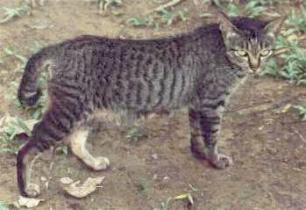
Some polydactyls (mitten cats) have double or triple dewclaws because the genes seem to give the instruction "add another digit to what is already present" rather than saying "produce 5 toes instead of 4" or "produce 6 toes instead of 4". Back in the 1960s, a cat lover in an English village reported a high incidence of polydactyl cats, mostly fathered by a local tomcat. Each generation of cats had more toes than the mother - as if the genes simply said "add another toe". Presumably there was either a limit to how many toes could be added or the tomcat left the area as the phenomenon was not reported again. There is a similar report from the USA. Each successive generation of a colony of barn cats had more toes than the previous one. Eventually this led to crippling. The colony was severely inbred with each generation being fathered by the same polydactyl tomcat. When he disappeared, a non-polydactyl cat took his place and no further crippled kittens occurred. I also received a first hand account of crippling in later generations of polydactyl barn cats (relating to the writer's grandmother's farm). This may be the same case. Although the latter report of inbred polydactyl farm cats claimed up to 12 toes per paw, this extreme number is unlikely; 8 or 9 is generally the upper limit. The gene is variable in expression so in these colonies, paws range from mitten-paws (with a "thumb") through to double paws.
So far, veterinary literature has not confirmed the "add another toe" gene. Even in the homozygous state (which would occur in inbred colonies), the most common form of polydactyly does not appear to be detrimental to health. However, there is another gene, which is sometimes (but not always) linked to polydactyly, which causes severe crippling. Radial hypoplasia (also called radial hemimelia) (RH) is discussed later in this article.
Classic polydactyly is probably an incomplete dominant. With a normal dominant trait, a cat either has the trait or doesn't have it. With an incomplete dominant there are different "levels" of the trait depending on whether the cat is homozygous or heterozygous for the trait, and also on whether other genes partially suppress the trait. A homozygous cat shows the trait more fully than a heterozygous cat. This may have been the explanation for the apparent "add another toe" form of the gene in the English village cats. Observation suggests that the incomplete dominant is expressed only 40%-50% of the time when inherited - this concurs nicely with the 50/50 split of polydactyl/non-polydactyl in Hemingway's colony. The suggested recessive form may also be due to incomplete dominance. The apparently "normal footed" cats would have been polydactyls with barely discernible extra toes, but whose offspring had more prominent extra toes - giving the appearance of either spontaneous mutation or recessive genes.
Because several different genotypes (genetic make-up) produced a similar or identical phenotype (physical appearance) it can be difficult to visually identify which cat carries which mutation. There are several forms of polydactyly due to several genes which produce a similar-looking trait and in the 2000s, the need to identify and isolate the various forms became crucial due to fears of a link with radial hypoplasia (Twisty Cat mutation). There was evidence for a second dominant form of polydactyly which resulted in a different form and structure to the familiar "mitten cat" form and which affected not only the paw, but the whole leg.
In summary, the most common form of polydactyly in cats is a simple autosomal (i.e. not linked to gender) dominant trait which does not affect the cat adversely and is not associated with other abnormalities. Despite suggestions of "natural snowshoes" there is no real evidence that polydactyly has any significant natural selective advantage or disadvantage. If it was disadvantageous, polydactyl cats would quickly have died out. It is simply an endearing anomaly. Though it is said that kittens inherit extra toes in exactly the same configuration as the polydactyl parent, this may not be 100% true because there are several gene mutations causing polydactyly. It is only likely to be true in controlled breeding programs where cats are carefully matched, but in the random-breeding population, the incomplete dominance of polydactyly means the configuration is variable - and it also depends on what genes the kitten inherits from the other parent!
In Maine Coons there was a successful effort to restore the polydactyl form of the breed. Non-polydactyl kittens born to a polydactyl parent appear to have heavier boning in the legs and chest than kittens born to two non-polydactyl parents. The Maine Coon breed also has two forms of polydactyly: mitten-foot and also patty-foot. In this breed, both forms are benign and there is no link to Radial Hypoplasia.
THE LINK BETWEEN RADIAL HYPOPLASIA AND POLYDACTYLY
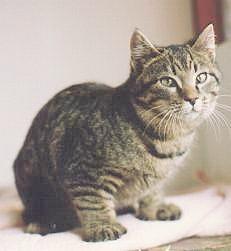
Most expressions of polydactyly are not a handicap to the cat (such as the polydactyl kitten pictured here). Polydactyly is also a feature of several more serious syndromes, e.g. a gene that causes a whole spectrum of effects ranging from extra toes through to radial hypolasia/radial hemimelia/radial agenesis (the "thalidomide" or "twisty" mutation) - "RH". The RH gene causes a condition known as triphalangeal pollex-radial hypoplasia. In mice, there are several gene mutations known to cause this form of polydactylism; unlike conventional "thumb cat" polydactyly, the mutations seem to cause more general disruption of limb formation in an embryo. The problem is that cats whose extra toes were caused by this gene (but whose legs were normal) could not be visually distinguished from those with a benign "patty-foot" mutation. Until DNA tsting became available, breeders avoided mating patty-foot cats together "just in case." In Maine Coons, extensive breeding has shown that they do not have the RH gene and are not at risk of deformity. PixieBobs are also NOT at risk. Polydactyl cats, whose ancestry and genetics are unknown, from backyard breeders are at greater risk.
In the 1990's an American breeder of "Poly-Bob" cats (a backyard breeder copy of PixieBobs) bred kittens with disabling twisting of the forelimbs. Though originally breeding for polydactyl bobtails she viewed the crippling trait as a cat breed less likely to run away and become wild. This was Radial Hypoplasia (RH). According to Towle & Breur the most common form of feline hemimelia is preaxial longitudinal intercalary radial hemimelia - absence of all or part of the distal half of the limb - and it was possibly hereditary ing in Siamese and domestic shorthair cats. It is a dominant gene. With this trait the pollex (thumb) has an extra joint, making it look more like a human finger than the usual rudimentary feline dewclaw. This triphalangeal (three-boned) thumb may be duplicated and sometimes the next digit is also duplicated. A cat with triphalangeal pollices (three-boned thumbs) may produce kittens with hypoplasia (underdevelopment) or aplasia (absence) of the radius, one of the two bones that make up the forearm. Hypoplasia means "underdevelopment of a given tissue." Radial hypoplasia means the radius bone is underdeveloped or missing. Though the scientific data was scanty (some owners of patty-foot cats reported offspring with RH) regarding the extra-jointed thumb being strongly linked to RH, rather than coincidental, geneticist Solveig Pflueger considered it best practice to avoid breeding from affected cats at that time. In the 30 years since then, it has been established that the Maine Coon's patty-foot mutation is NOT linked to RH.
Because the usual form of polydactyly is so variable in expression, X-rays were needed to distinguish between the different forms of polydactyly. Although the patty-foor was seen in some RH cats, not all cats with additional same-length toes have the variably expressed RH gene. In cats without dew claws or visible thumbs, an X-ray was required to determine whether the radius was deformed. Nowadays genetic testing is continually improving.
In recognised polydactyl breeds, cats without dewclaws are disqualified from shows (standards call for distinct thumbs) but may safely produce normal-footed show-quality offspring. In these breeds, it is safe to breed poly-to-poly without risk of limb deformities. Hopefully few, if any, individuals knowingly breed from cats whose polydactyly is caused by a serious syndrome.
According to Danforth and to Chapman & Zeiner; polydactyly is never observed in the hind feet except when it is also present in the front feet. Since polydactyly has variable expression, the extra digits on the front feet might not be evident, or they could be suppressed by other genes. A hind-foot only polydactyl may have extra digits on the front feet that are not readily discernible or can only be found by x-ray. The following photos show Aurora, a hind-paws-only polydactyl Maine Coon kitten bred from non-polydactyl bloodlines by Paul and Natasja in The Netherlands. There are no poly cats within the first six generations and parents, grandparents, about 30 relatives and also related lines are non-polydactyl. Aurora's 3 brothers have no signs of anything similar.
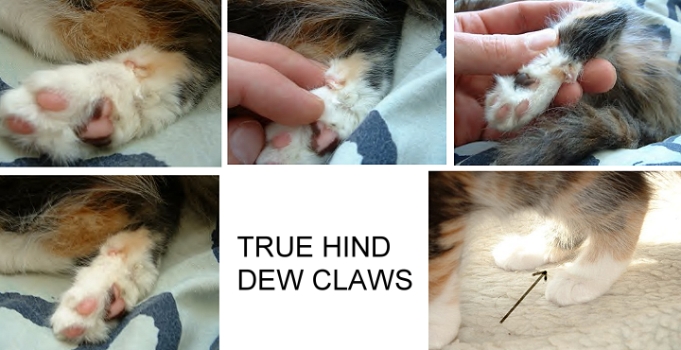
Aurora has true dewclaws on both her paws. They form a normal thumb and are complete: footbed, nail and muscles. Usually extra toes only occur on the back feet if the front feet are also polydactyl. Aurora does not have polydactyl front paws. Also unusually, the extra toes on the back paws are true dew claws, placed higher up than ordinary toes. According to Paul "We only discovered it last Friday, when Natasja thought her headache was playing tricks with her. She checked four times if the tail was still at the back, and it still was."
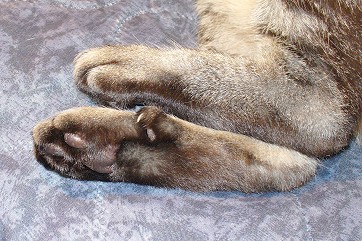
A similar case has apparently occurred in a Norwegian Forest Cat but there is no further information. Another has turned up in a Manx out of British bloodlines and has not been inherited by any of his offspring (ruling out a dominant gene). Current thoughts are that it is a random mutation, the result of polygenes meeting up or a non-genetic developmental trait. A recessive gene would have shown up in other cats. Aurora will later be test-mated to see if the trait is hereditary.
Stacey Bliss also has a hind paw polydactyl which had an extra toe on the right hind paw and lacked front dew claws. She had previously produced mitten cats, including Stacey's silver tabby cat Mia, and recently gave birth to a male orange kitten with no front dew-claws, but with extra toes on the hind paws. The kitten's front feet were at first at an odd angle, being bent down more like a human's wrist, but as he began to crawl and eventually walk, his feet flattened out. Stacey believes it may have been due to some lack of bones in the feet, but sadly the kitten vanished at the age of 10 weeks before this could be investigated. Mitten-pawed Mia is due to have a planned litter in Spring 2005, after which she will be spayed, and it will be interesting to see what form of polydactyly she passes on.
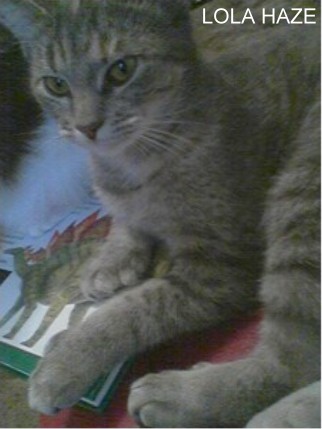
Nicole S's tabby cat Lola Haze has a seven-toed arrangement on the front paws and an unusual "thumb" or dewclaw on the back. One of the extra toes on her front paw may need the claw removed as it grows at an awkward angle and is not worn down by stropping. She uses her thumbs efficiently, especially to hold her tail up in front of her face when grooming herself - something slightly alarming to watch.
Pamela Alley's "Beaker" also had front paws bent at the wrist. He was an orange-and-white male one of 5 kittens born in 1984 to a random-bred female in a barn in Yreka, California, USA. Both of Beaker's front feet were firmly bent at the 'wrist'. He was significantly polydactyl with 7 toes on the front and 6 on the back. Pamela gently stretched the feet to normal positioning, and after about 2 weeks he was able to use his feet normally. He had to have the dewclaws removed as there was a danger of the boneless claws catching and ripping off the pad and attached skin; this still left him with 6 toes on each front paw. Beaker reached the grand old age of 17.5 years.
MINOR PROBLEMS WITH POLYDACTYLY
In general, polydactyly causes no ill-effects in cats. It is not a handicap and is an anomaly rather than a deformity. Some owners like to have the extra toe removed for cosmetic or safety reasons, but cats rarely catch the extra toe(s) on furnishings. In rare cases, nail growth can be affected, but only if the extra toe is incompletely formed and the nail bed is deformed. This can lead to ingrowing claws, overgrown claws or a fused "superclaw". Sometimes a claw develops between the thumb and the rest of the paw as Brian Tinker describes regarding his grey cat "Buddy". Buddy's back paws have 5 toes each, 4 normal ones and 1 dew claw. His front paws have between 5 and 7 toes each. The left front paw has 4 normal toes and an opposable thumb that remains underneath the paw and cannot lay in line with the rest of the toes. Between the opposable thumb and the regular toes (i.e. in the angle or crevice) was an additional claw. This was not associated with a toe and simply stuck out from the skin, unfortunately tearing the surrounding skin. Above the thumb is a vestigial toe that is only discernible through handling. On the right front paw, a similar vestigial toe has a segment of extra, jointed bone that can be felt and seen, but has no muscles or tendons controlling it (it can be freely wiggled up and down by the owner). On the right front paw, the thumb lies in line with the rest of the toes, but can also wrap downwards as an opposable digit. One of the claws on the right thumb became deformed and curled around on itself. The claw had died and snapped off easily. The nail-bed has since been removed.
Overgrown claws are more common in polydactyls because the extra toe is often shorter than the regular toes or it points in a slightly different directions. The cat is unable to strop the extra claws on a scratching post. Unless clipped regularly, the claw can become overgrown and embed themselves in the paw pad. Ingrowing claws grow twisted or crooked instead of growing straight with a smooth downward curve. Ingrown claws can grow into the paw pad and need either more frequent clipping or surgical removal. In the UK, such problem claws are the only time when declawing (of the affected toes only) is permitted. Ingrowing dewclaws can occur any cat where the claw grows into side of the foot. If the claw is set in such a way that it snags on furnishings etc, it can tear and infection can set in. Nail-bed infections or nail bed damage can lead to abnormal claw growth e.g. thickening or twisting. Where the toes are cramped together, the skin between them should be checked for infection as it provides a handy undisturbed crevice for bacteria. In general, the cat's own cleaning routine should prevent this, but if the toes cannot be spread then its tongue cannot easily clean between them.
If two extra toes are fused together, the nail bed will also be fused. The claw that grows from this dual nail bed can also be fused, leading to something known colloquially as "superclaw syndrome". The fused claw or "superclaw" is thicker than a regular claw and may twist abnormally. A non-twisting superclaw is not normally painful for the cat, but because the claw is thicker and stronger than usual, it can gouge wood - and flesh - more deeply than a regular claw. If the superclaw grows twisted, there is a danger that it will become ingrown. If the extra toe causes repeated problems, it can be removed in a straightforward operation, but this is rarely necessary.
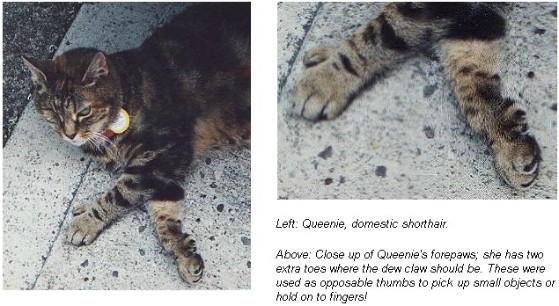
In the 1920s, there was interest in establishing the Polydactyle as a breed. Cat Gossip, 22nd May 1929 reports We have received a most interesting letter from Miss Oldfield Howey, who has for a long time been seeking for information concerning the origin of polydactyle cats. She has recently met a lady who tells her that they are Siberian, and were imported by the Government during the War to fight the rats in the docks, as their large, powerful feet and extra claws were supposed to give them a great advantage over the ordinary British cats, and they were said to be more sporting. The type is a very dominant one, and, once introduced, is difficult to breed out again. Miss Howey has herself proved this to be true, since without any artificial selection it has continually reproduced itself in her cats, since it first appeared in the litter of an adopted stray not herself polydactyle. Miss Howey s informant is the owner of a shorthair male, with eight claws on the front feet, obtained from Liverpool docks, and this cat treads heavily, not noiselessly like an English cat, and is a fine ratter. Miss Howey is still thirsting for more details about Polydactyle cats, and hopes that some reader of Cat Gossip may be able to tell me whether they were originally long or shorthair, and whether they have any special characteristics as well as the extra claws. Alost of the Polydactyle kittens in her cattery are born with drop ears, and retain them sometimes for weeks, though they eventually take the ordinary form.
The response from the magazine s former editor appeared in the same issue: Mr. H. C. Brooke writes us: The information given Miss Oldfield Howey as to their origin is erroneous. I doubt if any Government, however foolish, however desirous of squandering the taxpayers money, would perpetrate the absurdity of bringing cats from Siberia to a cat-infested country Even if each such cat caught daily three more rats than an ordinary cat, would the purchase be worthwhile? But even assuming, for the sake of argument, that this was done, the origin of these cats would by no means be accounted for. They exist and have existed in all countries. Thirty odd years ago I showed a Manx with all four feet bearing each four extra digits. It is a freak, and undoubtedly reproduces itself with some pertinacity. Let us be content with that, and not strive, as has been done, to make out that it is a provision of Nature,' etc., etc., to enable them to take their prey more easily. Were this the case Nature would seem rather foolish not to thus improve some wild felines, whose existence depends entirely on their power of grabbing.' As a matter of fact, in very many Polydactyles the extra digits are practically useless.
Far more interesting is the fact mentioned by Miss Howey as to the dropped ear. Apparently another freak, which if it only persisted with age would explain to us the legend (?) of the Chinese Drop-Fared Cat, the puzzle of two centuries. No doubt many properties in various animals were originally such freaks ; probably the first canine which dropped its ears out of the normal upright position of the canine ear, was so regarded. Polydactylism occurs in the human race, both on feet and hands, but I ve never heard it suggested this was a provision of Nature to enable the human being the better to do this, that, or the other. Such human polydactylism is heritable, as in the cat, but no one has found it so beneficial that they have striven to found a polydactylous strain of humans. The cat, probably owing to its extreme sensibility, seems very prone to freak formations.
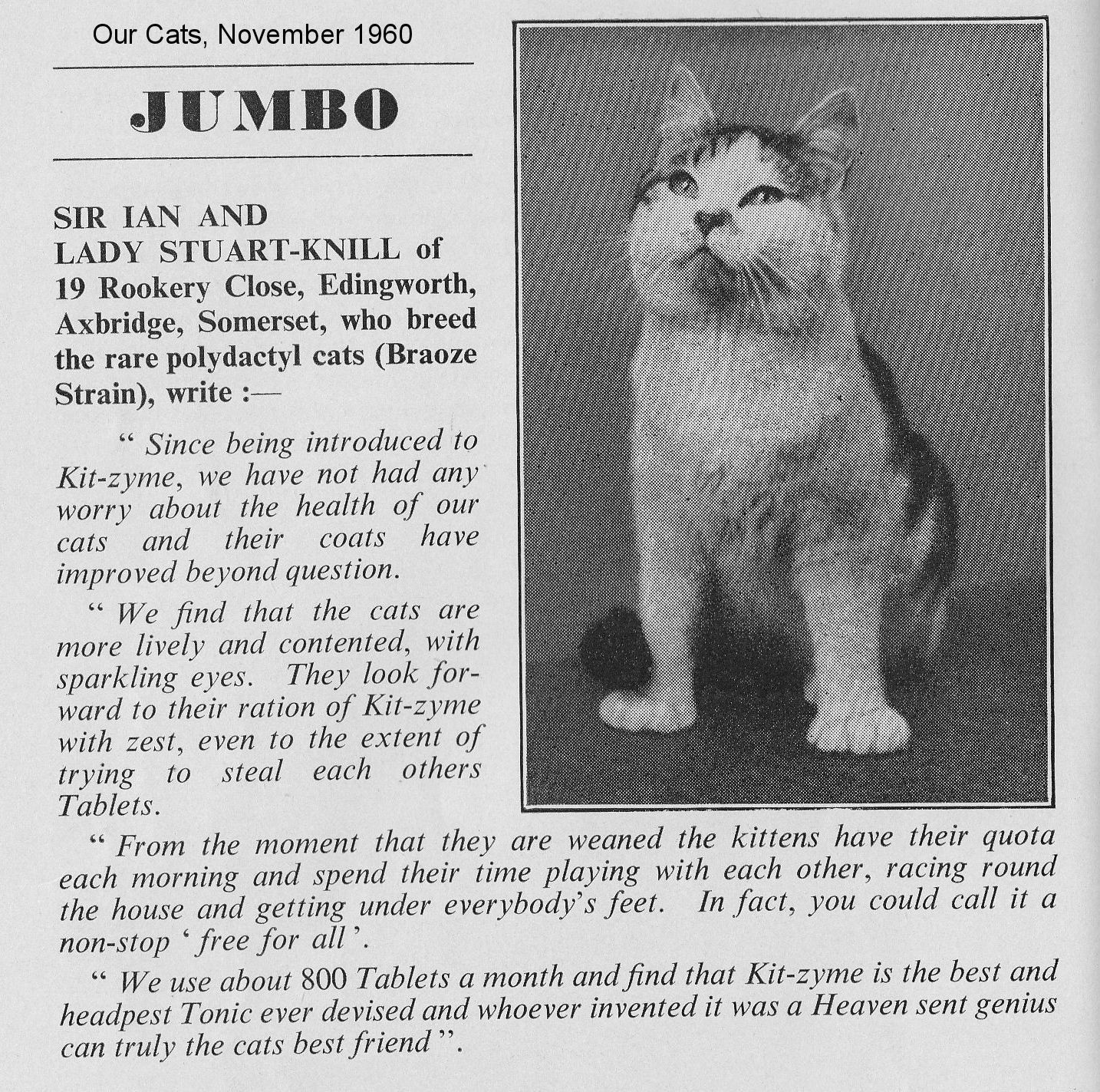
Historically, the polydactyl made up 40% of the original unregistered Maine Coon population. There are claims that the extra toes acted as snowshoes, helping these rugged cats negotiate snowy New England winters. Local folk tales claimed that these cats were fierce hunters who used their oversized paws to catch live fish, even taking fresh fish home to feed their owners! However, breed standards made no allowance for polydactyl Maine Coons and stipulated a normal foot configuration. Because polydactyly in the Maine Coon is due to the autosomal dominant gene, the trait could easily be eliminated by breeding only from non-polydactyl Maine Coons. The trait was deliberately bred out of Maine Coons and only recently have there been attempts to reinstate it.
Selection against polydactyly means the trait seems to have become associated with the term "harmful deformity" in many minds and there have even been postings on Usenet stating, quite erroneously, that "polydactyl cats almost always have some other sort of abnormality". Many cat registries happily recognise breeds defined by mutations which can have lethal or crippling effects such as spina bifida in the Manx, but refuse to permit polydactyl cats as either breeds or breed variants. Some cat enthusiasts feel that registries are right in refusing to accept polydactyl cats, fearing that breeders would try to produce cats with excessive and disabling numbers of toes on each paw. Since polydactyly doesn't work in this way and the number of toes appears to be limited, those fears are largely unfounded. In addition, breed standards could be written to define the maximum number of toes in polydactyl breeds to discourage such attempts.
Polydactyly is one of the traits of the PixieBob breed. Early write-ups on this breed suggested that only normal-footed PixieBobs would be accepted for shows. What one registry would not accept, another embraced and as well as the American Polydactyl, PixieBob and Polydactyl Maine Coons there are other polydactyl breeds being developed including the Hemingway Sphynx (a hairless polydactyl cat) now called the Dossow Cat and of developing polydactyl Munchkins a (short-legged polydactyl). The Mojave Spotted (formerly Hemingway Spotted) is being developed from Bengal x Polydactyl crosses. Several breeders in Illinois are working with a curl-eared polydactyl cat called Impians (previously called Tulips). Impians were originally developed in the 1990s by crossing American Curls with polydactyls, creating a harlequin patterned semi-longhaired breed. The markings, which can be any colour, are restricted to the head, down the spine, shoulders, hips and tail.
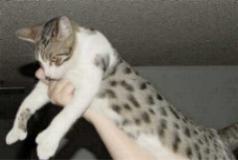
Mojave Spotted (formerly Hemingway Spotted): Developed from Bengal x Polydactyl crosses.
In New Zealand, a polydactyl breed called the Clippercat is under development. These are descended from domestic cats that are themselves descended from polydactyls that reached the country on the Clipper Ships between 1850 and 1900.
In Britain, polydactyly is considered a serious breed fault or defect. According to one breeder, polydactyls can be shown but cannot receive certificates or a first prize in the GCCF. Other sources state that the GCCF absolutely prohibits the showing of polydactyl pedigree cats and that they would be turned away during vetting in (with exceptions for those shown as household pets). A complete bar on the showing of polydactyl cats would be especially unfortunate for owners who wish to show polydactyl household pets and in some registries (FIFe), the prejudice is so great that polydactyl cats were banned from Cat Association shows. They feel that encouraging such abnormalities encourages inbreeding. The blunt statement is that polydactyly is a fault and cats with such defects are not allowed to be shown. This is a totally inconsistent approach since taillessness is also a fault, yet the Manx breed is perpetuated and shown. There are far fewer detrimental side-effects associated with polydactyly than there are with the Manx. The usual argument in these cases is that the Manx is a historical breed even though the polydactyly trait is equally historical. Not to mention that such bodies recognise ultra-typed or extreme Persians whose faces are so compressed that their tear ducts are distorted and their breathing may be compromised. It has to be noted that cat fancies are consistently inconsistent in their approach in such matters!
The GCCF is an extremely restrictive and conservative cat fancy. Its "Standard list of withholding faults - all breeds" (dated 13/10/95) states that certificates and first prizes be withheld for a number of defects considered undesirable in breeding stock and detrimental to individual cats. This includes "Abnormal number of toes - anything other than four toes on each foot and one dew-claw on each foreleg." This applies only to pedigree breeds; non-pedigrees do not have standards of points. This withholding is usually academic, because cats with "defects" (according the GCCF definition of defect) should not pass the vetting-in stage. The "Rules, section 5, veterinary surgeons" (effective 1 June 1997) has Rule 10 which bars "Exhibits which have been declawed should be rejected (see Section 4 Rule 14) together with polydactyls and cats with folded ears, curly tails or any other abnormality. With the exception of declawing, this does not apply to unregistered non-pedigree exhibits." In spite of its stance on abnormalities, the GCCF's double standards means it has not prevented the increasingly abnormal ultra-typing of Persians or Siamese. Even though non-pedigrees are not covered by the GCCF ban on showing polydactyls, it is possible that some judges mark down a polydactyl in the non-pedigree classes because of ingrained views that it is a defect.
The British prejudice against polydactyly may have to change following the importation of PixieBobs into Britain in 2004. In The Netherlands and Belgium, there is a move to restore the polydactyl lines of Maine Coon and the attitudes of the European registries, particularly FIFe, may also have to change. However, in Germany, the prejudice has legal backing as it is forbidden to breed cats (and dogs) that have genetic defects. "Defects" encompasses the harmless anomalies as well as the more harmful mutations. During 2009 the Governing Council of the Cat Fancy (GCCF) strengthened its anti-polydactyl stance (this primarily affects the Maine Coon Polydactyl and Pixie-Bob). While other World Cat Congress member registries accept polydactyly as a harmless trait in these breeds, the GCCF remained close-minded and insistent that polydactyly is a genetic defect. At the April 2009 World Cat Congress meeting in Arnhem, The Netherlands, the GCCF delegate responded "Never!" when asked if and when the GCCF would accept polydactyly. In spite of discussions by scientists at the meeting, the GCCF's position is that polydactyls are at "greatly increased risk of deleterious impact" and therefore should not be recognized nor accepted in the (Maine Coon) breed. The GCCF disregarded a British report into polydactyly known as the "Edinburgh Study". The GCCF have also produce a draft rewrite to the Breeding Policy which will refuse recognition to any new breed based upon structural anomalies and specifically includes polydactyl feet. With such closed minds, the more enlightened, registries active in Britain will benefit.
In Germany, the Federal Government erroneously decided polydactyly was a semi-lethal (deferred-lethal) defect and have banned the deliberate breeding of polydactyl cats under their Animal Protection Law. They based the decision on a paper by S & H Willer ("Gene Sites and Alleles of Domestic Cat with Pathological Effects or Side Effects") which stated, erroneously, that polydactyly is and "autosomal dominant semi-lethal error with modificator effect." V Schmidt und M. CH Horzinek refer to S & H Willer's mistake that polydactyly is semi-lethal in the German book "Krankheiten der Katze" (Diseases of the cat). As well as this error, an unsubstantiated fact (or propaganda) states that polydactyl kitten suffer a 50% mortality rate during the first 6 months and that polydactyl cats live in pain. In fact the kitten mortality rate in polydactyls is no different to that in normal-foot cats (the possible exception being those caused by the distinct and disabling radial hypoplasia condition).
Having persuaded the American cat fancy that polydactyly was not a deformity, the trait was soon back in the feline geneticists' spotlight due to its unfortunate association with the Twisty Cat. Twisty Cats have a crippling deformity of the forelegs. They arose spontaneously when a horse-breeder began to breed Poly-Bobs, a type of cat sometimes confused with the PixieBob. Some Poly-Bob litters contained kittens with flipper-like forelegs. The mutation is occasionally found at random in the cat population, but was occurring with greater frequency in Poly-Bob litters. This was the second form of polydactyly and its effects ranged from the Poly-Bob's simple extra toes through to the Twisty Cat's vestigial or missing long bones of the leg.
Some breeders and cat lovers became concerned that the Twisty trait was the hidden downside of polydactyly and that "all polydactyly was bad" despite the fact that perfectly healthy extra-toed cats have been around for hundreds of years. Most forms of polydactyly are no more than a harmless and attractive quirk. In polydactyl cats, it has become important to work out which ones have which gene, so that breeders working with polydactyls do not inadvertantly breed crippled kittens.
In 2006, TICA proposed to clamp down on certain breeding trends, including the creation of new polydactyl breeds created through crossing to other breeds. Their Genetics Committee report stated: "The Committee proposes that TICA does not accept any proposed breeds for Registration Only status that do not exhibit novel mutations. The current mutations would be reserved for currently recognized breeds exclusively. This would end the seemingly endless applications for "munchkinized" new breeds, and then deter the inevitable introduction of "rexed", "Bob-tailed" and Poly-ed" everything else."
Polydactyly is not limited to domestic cats. It is also found in big cats, though this is less widely reported for the obvious reason that we do not (normally) share our homes with big cats!
In 1925, The Journal of the Bombay Natural History Society published a photograph of a polydactyl leopard. It had an extra claw-bearing toe on each hind paw. Several years earlier it had published a letter regarding a leopard shot by S Eardley-Wilmot - this creature had an extra claw-bearing toe on each hind paw. In 1946, the same journal published a letter from another big game hunter who had also shot a leopard with extra toes (again fully functional with claws) on the hind feet.
Probably the most interest fact is that the leopards had the extra toes on the hind feet and not the front feet whereas in domestic cats, the hind feet are only affected if the forepaws are affected. This means that a different gene was responsible for hind-foot polydactyly in leopards ... and what can occur in a big cat might possible one day appear in domestic cats.
There are unverified reports of polydactyl tigers in China. The tale of a race of unusually large tigers with "thumbs" would appear to be exaggeration, but it is conceivably based on polydactyl individuals. None have been captured or photographed.
GLOSSARY REFERENCES